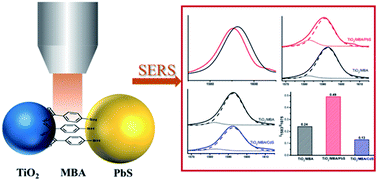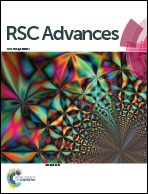SERS as a probe for the charge-transfer process in a coupled semiconductor nanoparticle system TiO2/MBA/PbS†
Abstract
A coupled semiconductor nanoparticle system composed of TiO2 NPs, 4-mercaptobenzoic acid (4-MBA) molecules and PbS NPs has been fabricated as a model to study the involved charge transfer (CT) effect using a Surface-Enhanced Raman Scattering (SERS) technique. In this TiO2/MBA/PbS system, the MBA molecules function as both a linker between TiO2 and PbS NPs and a SERS probe to reveal the CT process. For the SERS enhancement behaviors of the CT-sensitive vibrational mode in 4-MBA and the Raman spectra of the phonon vibrational mode in TiO2 NPs, there are some evident changes after adding PbS to the TiO2/MBA system. These changes are due to the interaction between TiO2 NPs and PbS NPs. We found that these differences, closely related to the natures of TiO2 and PbS NPs, are a reflection of the enhanced TiO2-to-molecule CT process in SERS. The SERS spectra of the TiO2/MBA/CdS system were also investigated and the result is in good accordance with our theory. This work will not only help in constructing nanoscale models to study interfacial CT processes but also be of considerable value for practical application of SERS technology.



 Please wait while we load your content...
Please wait while we load your content...